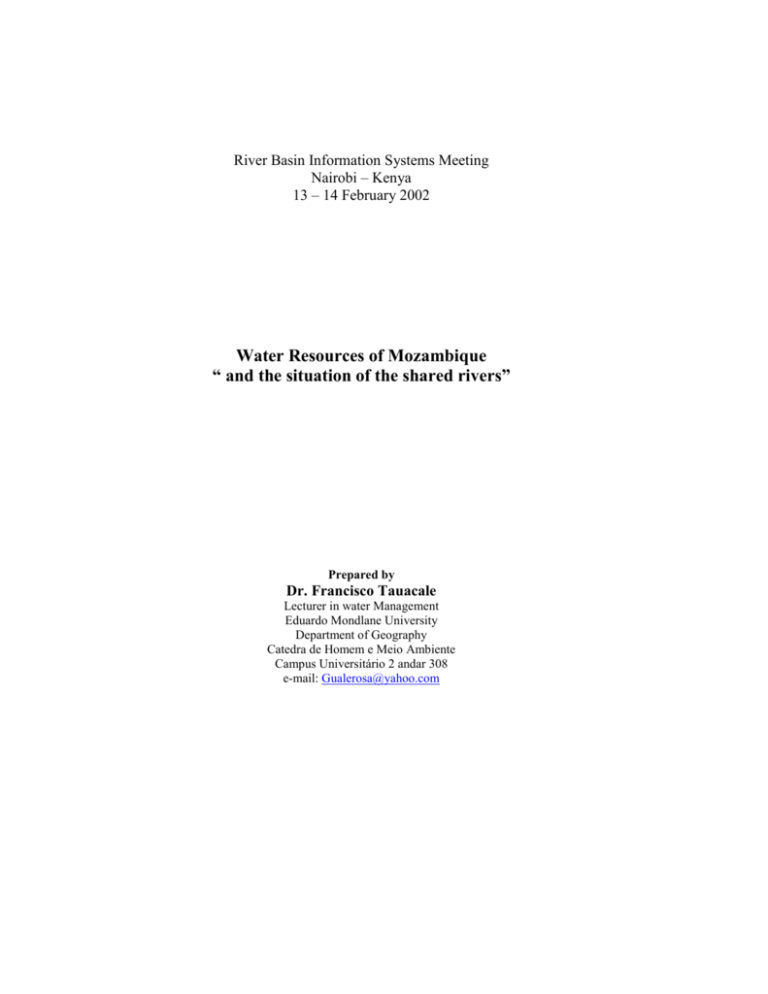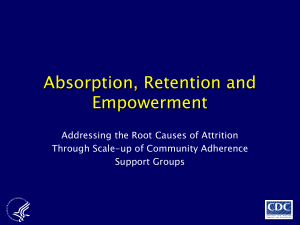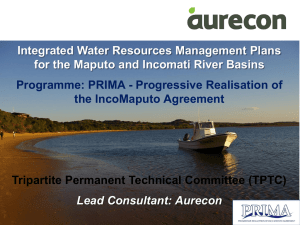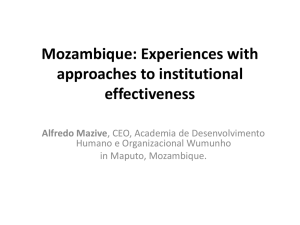Water Resources of Mozambique
advertisement

River Basin Information Systems Meeting Nairobi – Kenya 13 – 14 February 2002 Water Resources of Mozambique “ and the situation of the shared rivers” Prepared by Dr. Francisco Tauacale Lecturer in water Management Eduardo Mondlane University Department of Geography Catedra de Homem e Meio Ambiente Campus Universitário 2 andar 308 e-mail: Gualerosa@yahoo.com Water Resources of Mozambique “ and the situation of the shared rivers” 1. Bref characterization of the country Mozambique lies on the East Coast of Africa between the parallesls 10º 27’ and 26º 52’ of south latitude and the meridians 30º 12’ and 40º 51’ west longitude. The country has a land border os 4,330 km and a coastline of 2,470 km. The land area is 799,380 km2, including 13,000 km2 of inland water. The country is bordered on the north by Tanzania, on the west by Malawi, Zambia, Zimbabwe, Republic of South Africa (Transvaal) and Swaziland, and on the south by the Republic of South Africa (Natal). 2. Rivers Basins Most of the rivers in Mozambique flow in a W-E direction, draining the water of the central african high plateau into the Indian Ocean. Mozambique has 104 identified rivers basins, considering only catchments of rivers that flow into the Indian Ocean. The coastal zone is considered as one catchment. (Consultec, 1998) With the exception of the small rivers draining the coastal zones, the majority of the rivers have a torrential reigime, with high waters during 3-4 months and low flows for the remainder of the year corresponding to the marked wet and dry seasons. The southern basin until Save are mostly formed the terminal reaches of the international rivers, such as the Maputo, Umbeluzi, Incomati, Limpopo and Save. They are characterized by low runoff coefficients, deep saline intrusion in the mouths ( reaching up to 50 km inland) wide and shallow rivers valleys with low storand consequent high evaporation losses and large flood-plane areas. In the center of the country, the river basins are almost entirely within Mozambique, rising on the border mountains and decreasing gradually in altitude until the sea where also intense saline intrusion occurs. These rivers have more permanent runoff as compared with the southern ones, not only because of the different climatic regime of the regions but also because of increasing upstream abstractions on the international southern river basins. The northern rivers, except for the Rovuma, originate from the plateau and mountains out of Mozambique, we have Lurio, Licungo, Messalo and Ligonha. Up north, the Rovuma rivers forms the border with Tanzania. (Atlas, 1998) Areas of river basins in Mozambique: Area (Km2) N. Basins Source: DNA 1998 < 1,000 50 1,000 – 10,000 40 10,000 – 100,000 12 > 100,00 2 Two river basin which occupy in Mozambique more than 100,000 Km2 are the Zambezi (140,000 km2) and the Rovuma (101,200 km2) The basins with more than 10,000 km 2 in Mozambique are besides Zambezi and the Rovuma ones and excluding the coastal zone ( which is not a river basin) . by decreasing order of areas in Km2. Limpopo (79,600) Lurio (60,800) Pungue (28,000) Licungo (27,700) Buzi (25,600) Messalo (24,000) Ligonha (16,300) Incomati (14,900) Gorongosa (13,200), Inharime (11,900), Govuro (11,200) (DNA, 1999) Same other river basin deserve mention, althoug their areas in Mozambique are smaller than 10,000 km2. Maputo, Umbeluzi, Save, Monapo and the Montepuez basin. The total area in Mozambique of these 18 rivers basins is about 572,500 km2, more or less 75% of the total area of Mozambique. 11 river are more than 300 km long in Mozambique. They are the Zambezi ( 850 km), Limpopo (560 km), Save (330 km), Buzi (320 km), Pungue (320 km), Licungo (336 km) Molocue ( 325 km), Lúrio ( 605 km) Montepuez (315 km), Messalo ( 530 km) and Rovuma ( 650 km). (DNA,1999) From the 18 main river basin that have been presented, 9 are shared with other countries: Maputo: RSA and Swaziland Umbeluzi: RSA and Swaziland Incomati: RSA and Swaziland Limpopo: RSA, Borswana and Zimbawe. Save: Zimbabwe Pungue: Zimbabwe Zambezi: Angola, Namibia, Botswana, Zambia, Zimbabwe, Malawi and Tanzania Rovuma: Tanzania The figure represents the position of Mozmbique in the shared river basins. With the single exception of the Rovuma, Mozambique is located at the downstream end of all the basins. This puts Mozambique in a vulnerable position as water developments in the countries located further upstream will tend to decrease the water flows to Mozambique while at the same time increasing the problens of water quality. Dimension od the problem: 52% of the Mozambique territoty is located in internacional river basins but Mozambique represents only 20% of the total area of these basins; more than 50% of the surface water of the country are inflows at the border. Almost 50% of the surface water resources are concentreted in the Zambezi (international) river basin. The management of these shared river basin and reaching agreements with the other riparian countries on water sharing and integrated water resources management is thus a priority for Mozambique. 2.2. The sitution of the principal rivers 2.2.1. The Maputo basin: Crosses an area of very rich bio-diversity, having been recognized as such by UNEP and included as one of the world’s conservation areas. 2.2.2. Umbeluzi: Shared with Swaziland – water supply for the capital Maputo , A dam (Pequenos Libombos)built in the 1980. Irrigated agriculture exists: In swaziland – large scheme and in Mozambique smallrs scheme. Both countries have signed an agreement for water sharing but this agreement is not favorable to Mozambique while also being technically very insufficient. 2.2.3. Incomati: Shared with RSA and Swaziland. Incomati is a basin, whose water is intensively used in RSA mainly for irrigation. Mozambique has also some important irrigation schemes. However, the flows in the main river have been very much reduced in the last 15 years. Now we have the salt intrusion problem. 2.2.4. Limpopo: A large river basin where is located the largest irrigation scheme of Mozambique (Chokwé). However, the intensive use of water in the upstream countries, especcialy in Zimbabwe and RSA, reduced very much the flows entering in Mozambique. The river is now dry during 3 or 4 months in a normal year, a situation that has never occurred before 1980. Problems of water quality at the border inflows are also being felt. 2.2.5. Save: Large basin. During the 1980s, zimbabwe went on with an intensive program for use water resources of the basin. As a result, the Save is now almost permanent dry. 2.2.6. The Zambezi The largest river basins in Africa and the most important one in Mozambique. It concentrates about 50% of the surface water resources of the country and about 80% of its hydropower potential. The Cahora Bassa dam, one of the largest reservoirs in the world, was built in the mid – 1970s for power production. Irrigation was developed in the Lower Zambezi, especially sugar cane. There are projects to expand the power capacity of Cahora Bassa and built another dam further downstream, Mepanda-Uncua. The other basins north of Zambezi are not much developed in terms of water use, being limited to some urban supplies and small scale irrigation. 3. Surface water The surface water are the country’s main water resource. Mean annual runoff is estimate at 216,000 mililion cubic metres (Mm3), of which only 100,000 Mm3 originates in rainfall inside Mozambique. The remainder originates in countries upstream, which is why this figure has been falling with the increased use of water in these countries. In terms of the geography distribution, five regions have been identified, bringing together contiguous river basins and they will be administered by the Regional Water Administration (ARAs), set up by the water law: ARA – South – includes all the basins south of the Save, and the Save river basin itself. ARA – Centre – covers all the basins between the Save and Zambezi basins. ARA – Zambezi – corresponds to the Zambezi river basin. ARA – Centre-North – covers the zambezi basin as far as Lúrio river, including the Lurio basin. ARA – North – Covers all the basin north of the Lurio basin. Table 2. Characterstics of the regions covered by the ARAs. Region Area (1,000 km2) Mean annual runoff (km3) Flow at border Generated in Mozambique Mean annual runoff (mm) Total Flow Generated in Total at border Mozambique South Centre Zambezi Centre-north North 192 84 140 196 168 17.0 1.2 88.0 0.0 10.0 3.8 18.4 18.0 35.2 24.9 20.8 19.6 106.0 35.2 34.9 89 14 629 0 60 20 219 129 180 148 109 233 758 180 208 Total 780 116.2 100.3 216.5 149 129 278 Source: Carmo Vaz, 1999 From the tables, one notes that the southern region is entirely dependent on the basin of international rivers. Mozambique is very dependent on water made available by the countries upstream, particularly in the southern region, where more than 80% of the mean annual runoff is received from neighbouring upstream countries. 4. Hydrometeorological networks and data processing Hydrometeorological data is an essential requirement for water resources management, basides others uses in fields like applied hydrology, agriculture, ecology and so on. In Mozambique, rainfall and evaporation are measured by various institutions, mainly public ones – DNA, INAM and INIA –but also by some private bodies like agricultural enterprises, the other variables are only measured by DNA or related bodies like the ARAs. HCB and EDM measure levels and discharges at Cahora Bassa and Chicamba dams.(DNA, 1999) 4.1. Rainfall network Measured by DNA, INAM, INIA. Same agricultural enterprises like “Sociedade agricola do Incomati”. Measurements of rainfall started in 1908. We have a lot until 1975 , INAM and DNA. After the independence, there was a significant decrease in the number of stations in operation. Table 3. Evolution of the rainfall network Institution 1975 DNA 341 INAM 155 INIA 15 Total 531 Source: DNA, 1999 1982 269 149 15 433 1996 78 44 4 127 4.2. Evaporimetric network INAM, INIA and DNA measure evaporation in a limited number of stations In 1982, there were 30 evaporimetric station of INAM, 15 INIA and 4 of DNA. Nowadays INAM 18 stations, INIA has 5 and DNA has 3, bringing the total to 26 stations. 4.3. Water levels and discharges Only DNA measures water levels and discharges in rivers and reservoirs, in hydrometric stations. These measurements are fundamental for the evaluation of the availability of surface water resources as well as for studies of floods and other hydrological analysis (DNA, 1999). Water levels are measured in scales, located at convenient points of the section. Usually, there is one reading per day but during floods there are three or more reading per day. Table 4. Evolution of the hydrometric network Year 1975 1976 1981 Nr.stations 260 314 259 Source: DNA & Consultec, 1998 1982 231 1992 58 1996 76 4.4. Groundwater, water quality, sediment transport Until now, DNA has not established a network for measuring groundwater levels, water quality and sediment transport. Thess in terms of sampling points, sampling frequency and quality parameters to be analyzed. It has a minimum network of 13 stations covering the rivers Maputo (2), Umbeluzi, Incomati (2), Limpopo (2), Save, Buzi, Pungue and Zambezi (3). However, only 6 were functioning.(DNA,1998) 4.5. Data collection and processing by DNA Acoding DNA (199), “before the creation of ARAs, the country was divided in 11 hydrometric sectors”, which in most of the cases coincided with the provinces. Now the ARAs are being established and the hydrometric sectors will be controlled gradually by then. In each hydrometric sector, there are readers (leitores) who are responsible for reading. 5. Conclusion The management of these shared river basin and reaching agreements with the other riparian countries on water sharing and integrated water resources management is thus a priority for Mozambique. If we need agreements, in the short term, one of the main priorities is the recovery and later expansion of the hydrometeorogical network, while at the same time modern technologies are introduced for data collection, transmission and processing. The problem from the water resources management is: - floods and droughts are part and parcel of the rivers of the region. - In vast area of the interior of south -centre of Mozambique (Incomati, Umbeluzi, Limpopo and Pungue) has loss land, caused by salt-water intrusion, resulting from the low discharges of effluents - Loss of bio-diversity, resulting from the low discharges of effluents 6. References Carmo vaz, A. Recursos hidricos de Moçambique, potencial, problemas politicos, associaçao Moçambicana de ciencias e tecnologia, Maputo, 1999. DNA, Programa Sectorial de Investimentos do sector da Água. Direcçao Nacional de Águas, Maputo, 1998. DNA, Country situation Report. Direcçao Nacional de Águas, Maputo, 1998. DNA, Provincial Towns water sector study DHV/Consultec, Maputo, 1995 DNA, Water resources of Mozambique, 1999







